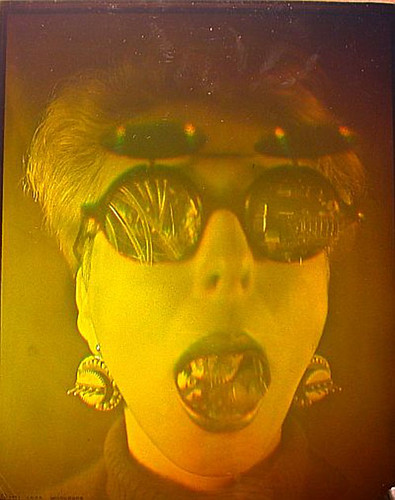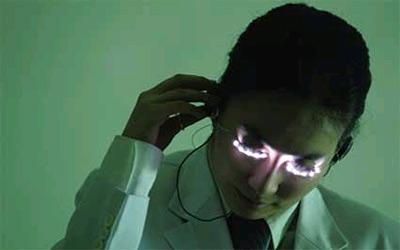
Artist Soomi Park from Seoul has created a set of LED eyelashes that light up in the dark. In an interview with We Make Money Not Art, Park describes the motivation behind her design:
I tried to project Korean’s obsession to big eyes, and how this fetishism is interpreted into excessive plastic surgery done on the eyes among Korean women. I really thought the obsession with big eyes can be represented through media design, because both yearning for bigger eyes and projecting the look through lights can be done by distorting the representation and creating new images. The LED Eyelashes have a mercury sensor that controls the light on the face. When wearing the LED eyelashes, you look embellished as if you were wearing a piece of fashion jewelry.
Politicized wearable art that invokes cybernetic technology? Marry me! In truth, you had me at “light-up lashes.” Read the article for more about the eyelashes and about Park’s compelling Digital Veil projet. The article mistakenly refers to Soomi as a boy, but she corrects the misconception in the comments. The interview is excellent nonetheless.
Related:
Posted by Nadya Lev on January 4th, 2008
Filed under Adornment, Art, Cyberpunk, Fashion, Fetish, Future, Technology | Comments (5)

Sorayama and Mac. Two great tastes that taste great together! Before you get too excited, these aren’t actual ads, just some design concepts like by Leif Olson – you can see the rest here. But how awesome would it be? Especially if all the ads were directed by Chris Cunningham, in the same style as this video? If I saw that, I bet even I would buy a Mac (full discloure: almost every friend I have, including the Coil-staff, loves the Mac. I love the PC. Too much Oregon Trail in elementary school).
Posted by Nadya Lev on November 26th, 2007
Filed under Cyberpunk, Fetish, Future, Japan | Comments (14)
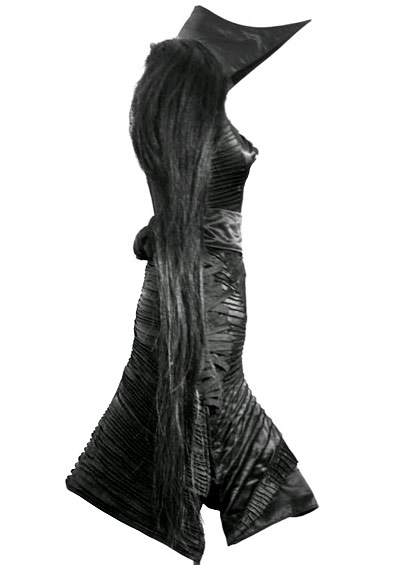
Degenerotika Clothing is a new alt fashion label by Slovenian artist/videographer/designer Tea Bauer. The clothing is gothic for sure, but there’s nothing pensive or frou-frou about it: the sharp, angular, textured garments look like they’re designed for dangerous people, people with unnatural reflexes and ambiguous morals. I can see Aeon Flux wearing this for a violent date with Trevor Goodchild, or Molly Millions donning this for a rare night out dancing on the Killing Floor.
The Degenerotika portfolio can be here, and I’ve included my favorite pieces after the jump. I’ll admit that some of the pieces are hit-or-miss for me, but when it’s a hit, it’s a stab straight to the heart. Tea has a clear voice and a unique perspective on alternative fashion. Definitely one to watch.
Posted by Nadya Lev on November 16th, 2007
Filed under Cyberpunk, Fashion, Fetish, Goth, Industrial | Comments (7)
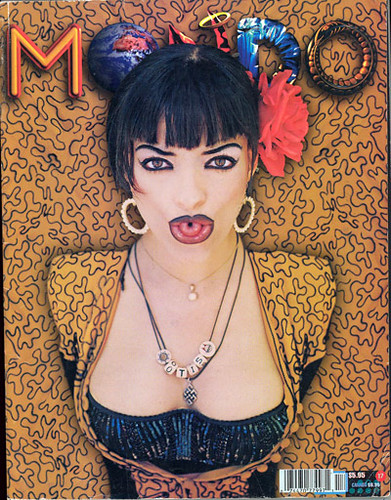
The last issue of Mondo 2000, featuring Nina Hagen on the cover.
I’m obsessed with dead magazines, especially ones that crossed over into the mainstream. The history of such magazines often sounds like a VH-1 Behind the Music special; first the group’s idealistic creation rises to fame on account of its originality, then comes the inevitable collapse due to in-fighting under the conflicting pressures of appeasing a wider audience, a set of advertisers and the project’s own artistic aims. More often then not, the problem is simply that such a magazine is way ahead of its time. This was the case with Mondo 2000, yet I’m grateful that it existed precisely when it did.
So, what made Mondo 2000 so special? It was, in my opinion, the best alternative culture magazine that America ever had. They wrote about smart drugs, brain implants, virtual reality, cyberpunk, Cthulhupunk and cryogenics. They covered Laibach and Lydia Lunch in the same issue. The pantheon of writers was a force to be reckoned with: Bruce Sterling, Robert Anton Wilson, and William Gibson all lent their talents, and there was even a Burroughs vs. Leary interview face-off. Then there was the famous U2-Negativland interview, in which Negativland, disguised as reporters, interviewed U2 into a corner to reveal the band’s hypocrisy over their lawsuit against Negativland over sampling. All in all, the magazine took risks. “The good dream for me and Mondo,” said editor R.U. Sirius in an interview with Purple Prose, “is overcoming the limits of biology without necessarily leaving sensuality or sexuality behind.” Issue after issue, Mondo 2000 threw a sexy dystopian bash and invited the decade’s best thinkers.

Posted by Nadya Lev on October 20th, 2007
Filed under Culture, Cyberpunk, Magazines | Comments (27)

Cheeky monkey Emily Rishea submits her fashion label, Artifice Clothing, through our submit form: “hey why not, I feel shameless,” she writes. Okay, we’ll bite! Artifice does a great job with all the classics and invents some new ones, such as these Victoria’s-Secret-meets-the-Rocketeer light-up mechanical wings. The range also has bit of a sense of humor, as can be seen in this Bunny Lolita ensemble, which the site describes as “terrifying”. But my absolute favorite item on the site has to be this Cybertek Collar, which makes you look like a Dr. Who villain from the Tom Baker era. In an era of Victorian future, the one person who rocks up wearing this as part of an outfit inspired by bad 1970s sci-fi tech will be the envy of the tea party indeed.
Posted by Nadya Lev on October 14th, 2007
Filed under Cyberpunk, Fashion, Goth, Technology | Comments (5)
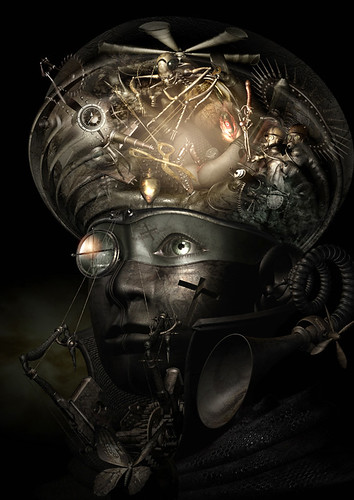
monorogue, originally uploaded by Coilhouse.
More Almacan images here.
Posted by Zoetica Ebb on October 12th, 2007
Filed under Art, Cyberpunk | Comments Off on Mechanical Mirage

Steve Pyke is an English photographer who covered the early cyberpunk scene. Pyke writes, “Cyberpunks, a small subculture, influenced by the work of the author William Gibson and particularly the film Bladerunner, existed in London in the early 1990s. I became interested and photographed a series of about fifty portraits in my studio over a short period.” Here’s a link to his image gallery, which features 16 portraits. I love his clean, streamlined, almost anthropological portraits of this small sub-genre. There’s something really charming about this original incarnation of the cyber aesthetic.
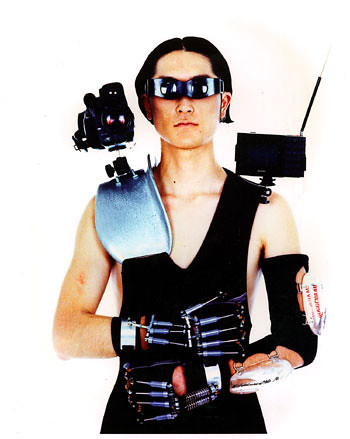
One thing I found really interesting about this series that almost half the people in the pictures have some sort of lenses concealing their eyes. This makes sense, because mirrorshades were one of the strongest symbols of cyberpunk writing from the late 80s and early 90s, starting with Molly in Neuromancer. This is why everyone in The Matrix also wears mirrored shades as an homage.
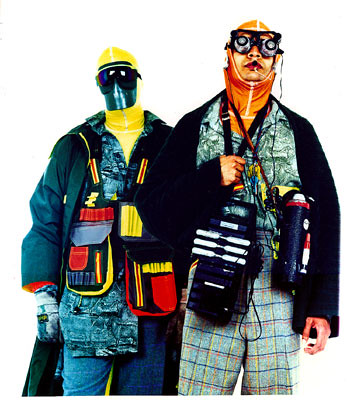
Here are the rest of Steve Pyke’s Cyberpunk Portraits.
Posted by Nadya Lev on October 11th, 2007
Filed under Cyberpunk, Fashion, Photography | Comments (2)
What i found through some quick googlemancery is a fairly large private collection of holographic photographs belonging to one Guillermito, apparently an admirer of technology in art and vice-versa. In a touching testimony he says “I think they are a perfect balance between esthetics and technology, between science and art…Buying fine art holograms is throwing money out of the window, financially speaking. You really have to love them. Because, basically, nobody cares.“.
We care, G. We care.
You can browse his online gallery here.
Posted by Zoetica Ebb on October 11th, 2007
Filed under Cyberpunk, Photography | Comments (2)












